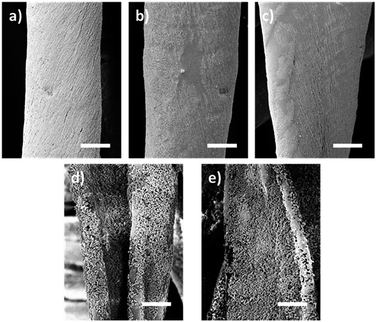Self-cleaning, superhydrophobic cotton fabrics with excellent washing durability, solvent resistance and chemical stability prepared from an SU-8 derived surface coating†
Chao Zeng,
Hongxia Wang,
Hua Zhou and
Tong Lin*
Institute of Frontier Materials, Deakin University, VIC 3216, Australia. E-mail: tong.lin@deakin.edu.au; Tel: +61-3-5227-1225
First published on 23rd June 2015
Abstract
Superhydrophobic cotton fabrics with a very low contact angle hysteresis were prepared using a single-pot coating solution comprising SU-8 (a negative photoresist), a fluorinated alkyl silane and silica nanoparticles. The fabric was treated using a dip-coating technique and subsequently cured under UV light. The coated fabric showed excellent superhydrophobicity with a water contact angle as high as 163° and a sliding angle as low as 2°. The coating was durable enough to withstand 100 laundry cycles. It also had excellent stability against long immersion times in organic solvents, and acid and base solutions.
Introduction
Superhydrophobic surfaces with high water repellency and low contact angle hysteresis (typically <10°) often have a bio-mimicking self-cleaning property. They have many applications in areas including protection of electronic devices,1 control of cell-substrate adhesion,2,3 wind-shielding for vehicles,4 oil–water separation,5,6 anti-fouling paints,7,8 and anti-icing protection.9 Fabrics with such a self-cleaning ability are very useful for making water-proof garments, fire-retardant clothes, personal protection clothing, soldiers’ uniform garments and work wear.10–13 The majority of self-cleaning, superhydrophobic fabrics are prepared by forming nano-/micro-scale rough surfaces and by decreasing the surface free energy. Techniques for making superhydrophobic fabrics include wet-chemical coating (e.g. dip-coating,14 sol–gel process15 and spin-coating16), surface deposition (gas phase deposition,17–20 plasma,21 electrostatic assembly22–24 and magnet-induced assembly25), and electrospinning.26 Wet-chemical coating is the most widely used because of the low cost, good homogeneity, and easy preparation on a large scale.For practical applications, functional fabrics are often required to be durable enough against repeated washing. Considerable efforts have been devoted to improving the durability of superhydrophobic fabrics. Several strategies have been developed to prepare durable superhydrophobic surfaces on fabrics, such as crosslinking the coating layer (e.g. through heating,27,28 UV29–33 or X-ray radiation34), covalent bonding between the coating and substrate,35–38 rendering the surface with a self-healing ability,39 and using nanocomposites.40–46
For some industrial applications, chemical stability and solvent resistance are vital. Some coatings for making durable superhydrophobic fabrics are reported to have a high chemical stability.34,35,47,48 For example, Chen et al.49 prepared a superhydrophobic fabric through surface coating with a PDMS coating solution containing TiO2–SiO2 nanoparticles, and the coated fabric was stable in acidic (pH = 2) and basic (pH = 12) conditions. Previously, our group has developed robust super liquid-repellent fabrics using fluorinated polymers and demonstrated the durability of the coatings to withstand the attack of acid (pH = 1) and base (pH = 14).45,50–52 In one of our recent works fabric was produced which could withstand 98% concentrated sulfuric acid and strong alkaline solution.53 In contrast, there are relatively less papers which have reported the preparation of solvent-resistant superhydrophobic fabrics. Yoo et al.54 reported the solvent resistance of a polyester fabric coated with a stacked polymer film through initiated chemical vapor deposition (iCVD). Zou et al.55 prepared solvent-resistant cotton fabric by solution phase grafting a diblock copolymer on the fabric surface. Zhao et al.22 from our group used a reactive self-assembly method to prepare a solvent-resistant, chemically-stable coating on cotton fabrics. However, solvent-resistant, durable, self-cleaning superhydrophobic fabrics prepared by a simple wet-chemical method (e.g. dip-coating or spraying) have not yet been reported in research literature.
SU-8 is an epoxy-based photoresist widely used for making optoelectronic devices, micro-electro-mechanical systems (MEMS)56,57 platforms and microfluidic devices,58 scaffolds for supporting cell growth and tissue repair,59 and ultrafine fibers.60,61 Recently, some researchers have reported the preparation of superhydrophobic surfaces on dense flat substrates using SU-8.62–66 However, self-cleaning, superhydrophobic fabrics prepared using an SU-8 based coating have not been proven.
Herein, we report a simple method to fabricate solvent-resistant, chemically-stable, washing durable, self-cleaning and superhydrophobic cotton fabrics through surface coating using a one-pot coating solution consisting of SU-8, fluoroalkyl silane and silica nanoparticles. Cotton fabric was chosen as the fabric substrate because it is a commonly-used textile material. The treated fabrics show excellent superhydrophobicity with a water contact angle of 163 ± 3° and a sliding angle as small as 2°. The coating slightly reduces the fabric air-permeability (from 30 cm3 cm−2 s−1 to 25 cm3 cm−2 s−1), but shows excellent solvent resistance. The coating can withstand over 100 repeated washing cycles, and long immersion times in acid and base solutions.
Experimental
Materials
Commercial cotton fabric (plain weave, 160 g m−2 and thickness = 520 μm) was used as the substrate. Tetraethylorthosilicate (TEOS, 98%) and ammonium hydroxide (28% in water) both from Sigma-Aldrich, fluorinated alkyl silane (FAS, tridecafluorooctyltriethoxysilane Dynasylan F8261) from Plastral Pty Ltd, and SU-8 from Microchem Corporation were used as received.Synthesis of coating solutions
A commercial SU-8 was magnetically stirred in the dark until a homogeneous solution of SU-8/acetone was obtained. FAS and hydrophobic silica particles which were prepared using a modified Stöber method were added in sequence to the SU-8/acetone. After 1 hour of magnetic stirring, the coating solution containing well-dispersed nanoparticles was ready for use.Coating treatment of fabrics
Before the coating treatment, the cotton fabric was rinsed with acetone and distilled water separately several times and dried at 100 °C for 30 minutes. A dip-coating method was employed for the coating treatment. The cotton fabric samples were immersed into the coating solution for 5 minutes, and then dried at room temperature for 30 minutes. The fabric samples were irradiated by UV light (intensity 80 mW cm−2) for 10 minutes and then further cured at 120 °C for 10 minutes.Characterization
The contact angles were measured using a contact angle goniometer (KSV CAM 101). The water drop for the test was 5 μl in volume. Scanning electron microscopy (SEM) (Supra 55VP) was used to observe the surface morphology under a 5 kV acceleration voltage. Fourier transform infrared (FTIR) spectra were recorded on a Bruker VERTEX 70 FTIR spectrometer in ATR mode. X-ray photoelectron spectra (XPS) were obtained on a VG ESCALAB 220-iXL spectrometer with a monochromated A1 Kα source (1486.6 eV) using samples of ca. 3 mm2 in size. The obtained XPS results were analyzed using CasaXPS software. The self-cleaning property was tested by putting dust (e.g. soil powder) on the fabric samples and then rinsing the contaminated surface with water. The washing durability was tested by reference of a standard procedure (AATCC test method 61-2006 no. 2A). In brief, an aqueous solution containing 0.15% standard detergent without optical brightener (WOB) was used as the washing solution. The fabric samples (50 mm × 150 mm) together with 50 stainless steel balls and a washing solution were added into a washing machine (Ahiba Nuance, AHIBA, USA). Each test was performed at 49 °C, with a spinning speed of 40 ± 2 rpm, for 45 minutes. After washing, the fabrics were rinsed with water, and then dried at room temperature. According to the standard, each washing cycle in this test was equivalent to five home laundry cycles. For convenience, home laundry cycles are reported in this paper. The solvent resistance was studied through immersing the fabric samples in five different organic solvents (acetone, ethanol, ethyl acetate, dimethylformamide and 2-butanone). The chemical stability was measured through immersing the fabric samples in aqueous solutions of seven different pH levels (pH = 1, 2, 4, 7, 10, 12 and 14). The water contact angle before and after the immersion treatment was measured. The fabric pore size was measured using a pore size meter (PSM165, TOPAS Company, Germany) using a perfluoro compound (Topas specific testing liquid) as the testing fluid, and the data were analyzed using PSM Win software.Results and discussion
Fig. 1a illustrates the chemical structures of the coating materials and the procedure for the coating treatment. The coating solution was dip-coated onto the cotton fabric in the dark, and the coating was subsequently cured via irradiation in UV light, followed by a heat treatment. After the coating treatment, the fabric turned hydrophobic. When water (10 μl) was dropped on the fabric, it formed a nearly-spherical droplet, which stayed stable for a long period of time (Fig. 1c). This is considerably different to the uncoated cotton fabric, in which the water droplet spread completely into the fabric matrix within a second (Fig. 1b).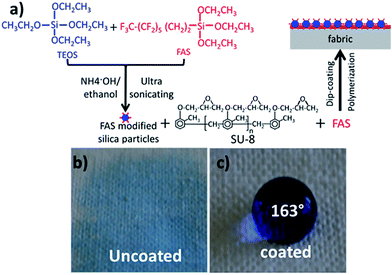 | ||
| Fig. 1 (a) The chemical structures of SU-8 and FAS, and the coating procedure, (b) & (c) photos to show water drops (10 μl each) on the uncoated and coated cotton fabrics, respectively. | ||
The effects of the coating components on the water contact angle (WCA), sliding angle (SA) and air permeability (AP) of the cotton fabric were examined. When the cotton fabric was just coated with SU-8, without FAS and hydrophobic nanoparticles, the SU-8 content in the coating solution affected the three properties with different trends. As shown in Fig. 2a, the WCA increased considerably from 0 to 131° when the SU-8 content in the coating solution increased from 0 to 0.4 wt%. Further increasing the SU-8 content led to a small increase in the WCA. When the SU-8 content was lower than 1.6 wt%, the SA decreased slightly to 20°. Further increasing the SU-8 content led to a decrease of the SA from 20° to 15°. For the coated fabrics, the air-permeability fluctuated at around 25 cm3 cm−2 s−1 except for the sample coated with 1.4 wt% SU-8 which caused an obvious increase in the permeability value. This can be explained by the effect of the coating on the pore size of the fabric. Under these coating conditions, the proportion of larger pores (size over 40 μm) increased after the coating treatment, while the proportion of the smaller pores remained at the same level (see the pore size distribution in the ESI†). This increased proportion of large pores was attributed to the shrinkage of the yarns in the fabric which was induced by the capillary effect during the coating treatment under these conditions. Since a 1.4 wt% SU-8 solution causes the fabric to have a high hydrophobicity with a small SA and an increased air permeability, 1.4 wt% SU-8 was chosen for further experiments.
Fig. 2b shows the effect of FAS in the 1.4 wt% SU-8 solution on the hydrophobicity and air-permeability of the coated fabric. When the FAS content increased from 0.7 wt% to 7.0 wt%, the CA increased initially and then decreased to 140°. The highest CA (155°) was found at a FAS content of 2.8 wt%. The initial increase in CA comes from the effect of FAS on the surface free energy. FAS is often used to lower the surface energy for superhydrophobic treatment. The further decrease in the CA at higher FAS content was attributed to the reduced surface roughness caused by the extra FAS on the coated fabric. In contrast, the presence of FAS in the coating led to a decrease in the SA. When the coating solution contained 2.8 wt% FAS, the coated fabric showed a SA of 15°. The SA value remained almost unchanged with further increasing the FAS content in the coating solution. The addition of FAS to the 1.4 wt% SU-8 solution for the coating treatment had little effect on the air permeability of the coated fabric.
When silica nanoparticles were added to the SU-8 solution, they affected the hydrophobicity and air-permeability of the coated fabric (Fig. 2c). When the SU-8 content was kept at 1.4 wt%, while increasing the nanoparticle content from 0 to 1.0 wt%, an evident increase in the CA, but decrease in the SA was observed. However, further increasing the nanoparticle content from 1.0 to 2.0 wt% led to very little change in both the CA and SA values. Different to CA and SA, the air permeability only showed a monotonic decrease with increasing the nanoparticle content when the nanoparticle content in the coating solution was less than 1.0 wt%. When the nanoparticle content in the coating solution increased from 1.0 wt% to 2.0 wt%, the air permeability value was almost unchanged.
When FAS and nanoparticles were both added to the SU-8 solution, the coated fabric had a higher CA but lower SA when compared with fabric coated with an SU-8 solution of the same content but contained only one of the additional components. However, the air permeability of the SU-8/FAS/nanoparticle coated fabric was lower than that of the coated fabric using the solution containing the same content of nanoparticles and SU-8 without FAS.
It is well established that roughness and surface free energy are two important factors deciding the hydrophobicity of a surface. SU-8 is inherently hydrophobic, while fabrics have a micro-scaled rough surface because of the texture structure. The cotton fabric just coated with SU-8 did not show superhydrophobicity (CA = 131°). However, when FAS was present in the coating layer, the coated fabric became superhydrophobic (CA = 155°). Fig. 3 shows the SEM images of the cotton fibers before and after coating with different materials. In comparison with the uncoated cotton, the fibers after coating with SU-8 or SU-8/FAS show a similar surface morphology (Fig. 3a–c). This suggests that SU-8 and SU-8/FAS have little effect on the fiber morphology, and the increase in hydrophobicity should come from the contribution to lower the surface free energy. When the fabric was coated with SU-8/nanoparticles, a particulate morphology can be seen on the fiber surface (Fig. 3d). In this case, the cotton fibers are considerably increased in surface roughness. By lowering the surface energy and meanwhile increasing the fiber roughness (Fig. 3e), the fabric coated with SU-8 containing both FAS and nanoparticles reached the highest CA (163°) but the smallest SA (2°).
FTIR and XPS were used to characterize the chemical components of the coated fabrics. As shown in Fig. 4a, after the coating treatment new peaks appeared at 1500 cm−1, which was assigned to the aromatic C![[double bond, length as m-dash]](https://www.rsc.org/images/entities/char_e001.gif) C vibration of SU-8. The peaks at 1240 cm−1 and 798 cm−1 correspond to the C–F and Si–O–Si stretching vibrations, respectively. The peaks at 1100 cm−1 and 1050 cm−1 are assigned to C–O and C–O–C vibrations.
C vibration of SU-8. The peaks at 1240 cm−1 and 798 cm−1 correspond to the C–F and Si–O–Si stretching vibrations, respectively. The peaks at 1100 cm−1 and 1050 cm−1 are assigned to C–O and C–O–C vibrations.
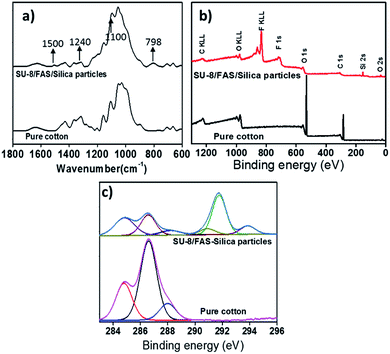 | ||
| Fig. 4 (a) FTIR spectra, (b) XPS survey spectra and (c) XPS high-resolution C1s spectra of the cotton fabric before and after the coating treatment with SU-8/FAS/nanoparticles. | ||
Fig. 4b and c show the XPS survey and high-resolution C1s spectra, respectively, of the cotton fabric before and after the coating treatment. After coating with SU-8/FAS/silica particles, two new elements, i.e. silica and fluorine, were detected on the fabric surface (see the element content in the ESI†). The C1s spectra indicated that the uncoated fabric contained C–C bonds (binding energy, 284.8 eV), C–O (286.5 eV) and O–C–O (288.1 eV) bonds. For the coated fabric, three additional broad peaks formed with binding energies of 291.3 eV, 292 eV and 294 eV, which are typically characteristic of the –C![[double bond, length as m-dash]](https://www.rsc.org/images/entities/char_e001.gif) C–, –CF2 and –CF3 moieties, respectively.
C–, –CF2 and –CF3 moieties, respectively.
Fig. 5 shows the CA and SA changes with the number of laundry cycles. The CA slightly decreased from 163° to 157°, whereas the SA remained lower than 8°, after 100 washing cycles. The surface morphologies of the coated fabrics after washing were observed. As shown in Fig. 5, some nanoparticles are removed after 60 washing cycles, and after 100 washing cycles more nanoparticles are removed from the fiber surface.
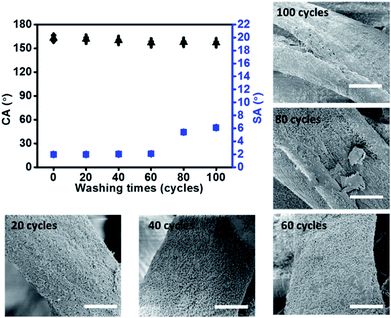 | ||
| Fig. 5 The CA and SA change with the number of laundry cycles, and SEM images of the coated fabric after different washing cycles (scale bar = 5 μm). | ||
The solvent resistance and chemical stability was tested through immersing the coated fabrics in various organic solvents and aqueous solutions of different pH values, respectively. The water contact angle and sliding angle were measured after immersion for different periods of time (up to 96 hours). Both the CA and SA showed no change after 96 h of immersion in the five organic solvents used, i.e. ethanol, dimethylformamide (DMF), acetone, ethyl acetate and 2-butanone (Fig. 6a, also see the detailed data in the ESI†). When the fabric was immersed in aqueous solutions, a thin layer of air was formed between the fabric and the water, and the fabric tended to float. To make the fabric come into full contact with the solution, a bulb pipet was used to remove the air layer. After 96 hours of immersion in the aqueous solutions with different pH values, both the CA and SA were almost unchanged (Fig. 6b, also see the detailed data in the ESI†).
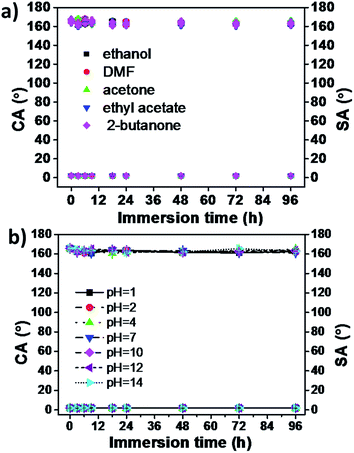 | ||
| Fig. 6 WCA and SA of the coated cotton fabric after immersion in (a) various organic solvents and (b) aqueous solutions with different pH values. | ||
The excellent stability against solvents and acid/base should stem from the chemical stability of the crosslinked SU-8. Upon exposure to UV, SU-8 crosslinks to form a highly crosslinked structure. The silane head of FAS is hydrolysable and can condense to form insoluble macromolecules. These make the coating highly stable in organic solvents and can withstand chemical damage. The epoxide groups of SU-8 also allow the formation of chemical bonds with the cotton substrate.
To test the self-cleaning ability, we placed dust on the coated fabrics and then cleaned the dust-contaminated surface by rinsing with water. As shown in Fig. 7a–c, the dust is easily taken away by the moving water droplet, resulting in a completely clean surface. However, the dust on the uncoated cotton fabric was hard to clean in a similar manner (Fig. 7a′–c′). This indicates that the treated fabric has a bio-mimicking self-cleaning property similar to lotus leaves.
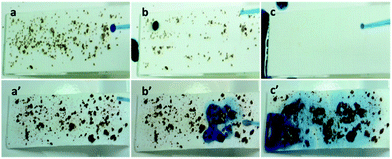 | ||
| Fig. 7 Still frames taken from videos showing droplets of water on the dust contaminated fabrics, (a–c) superhydrophobic coated fabric, and (a′–c′) uncoated cotton fabric. | ||
In addition, the coating showed a small influence on the fabric rigidity (see the bending length result in the ESI†). Apart from cotton, we also used other fabrics such as polyester and wool fabrics for the coating treatment. As expected, the fabrics after coating became superhydrophobic (see the ESI†), suggesting that the coating system is suitable for the treatment of different types of fabric.
It should be indicated that the SU-8 in the coating functions as a coating matrix to host FAS and nanoparticles. Because of the chemical reactivity, the SU-8 could also form chemical links with the cotton substrate and nanoparticles (through hydroxyl groups), which enhances the adhesion. Crosslinking of the SU-8 allows the coating to have excellent chemical durability and solvent resistance. In comparison with other sticky polymers, e.g. polyacrylate and polyurethane, SU-8 easily forms chemical bonds with the fabric substrates, which facilitates enhancement of the durability, chemical stability and solvent resistance.
Conclusion
We have prepared a self-cleaning superhydrophobic cotton fabric using a one-pot coating solution comprising the commercial photoresist SU-8, a fluorinated alkyl silane and silica nanoparticles. The coated cotton fabrics have high superhydrophobicity with a very low contact angle hysteresis. The coating shows excellent durability against organic solvents, acid and base solutions, as well as repeated washing. This superhydrophobic coating may be useful for developing functional fabrics for various applications in personal protection clothing.References
- L. Mishchenko, B. Hatton, V. Bahadur, J. A. Taylor, T. Krupenkin and J. Aizenberg, ACS Nano, 2010, 4, 7699–7707 CrossRef CAS PubMed.
- Y. Wang, C. E. Sims, P. Marc, M. Bachman, G. Li and N. L. Allbritton, Langmuir, 2006, 22, 8257–8262 CrossRef CAS PubMed.
- E. Galopin, G. Piret, S. Szunerits, Y. Lequette, C. Faille and R. Boukherroub, Langmuir, 2009, 26, 3479–3484 CrossRef PubMed.
- D. Quéré, Rep. Prog. Phys., 2005, 68, 2495 CrossRef.
- L. Feng, Z. Zhang, Z. Mai, Y. Ma, B. Liu, L. Jiang and D. Zhu, Angew. Chem., Int. Ed., 2004, 43, 2012–2014 CrossRef CAS PubMed.
- H. Wang, H. Zhou, H. Niu, J. Zhang, Y. Du and T. Lin, Adv. Mater. Interfaces, 2015, 2, 1400506 Search PubMed.
- A. Scardino, R. De Nys, O. Ison, W. O’Connor and P. Steinberg, Biofouling, 2003, 19, 221–230 CrossRef PubMed.
- L. D. Chambers, K. R. Stokes, F. C. Walsh and R. J. Wood, Surf. Coat. Technol., 2006, 201, 3642–3652 CrossRef CAS PubMed.
- H. J. Lee, J. Mater. Sci., 2012, 47, 5114–5120 CrossRef CAS.
- B. Mahltig and H. Böttcher, J. Sol-Gel Sci. Technol., 2003, 27, 43–52 CrossRef CAS.
- T. Bahners, T. Textor, K. Opwis and E. Schollmeyer, J. Adhes. Sci. Technol., 2008, 22, 285–309 CrossRef CAS PubMed.
- Q. Truong and E. Wilusz, Smart Textiles for Protection, 2012, p. 364 Search PubMed.
- P. Gibson, Text. Res. J., 1993, 63, 749–764 CrossRef CAS PubMed.
- M. A. Shirgholami, M. S. Khalil-Abad, R. Khajavi and M. E. Yazdanshenas, J. Colloid Interface Sci., 2011, 359, 530–535 CrossRef CAS PubMed.
- M. Yu, G. Gu, W.-D. Meng and F.-L. Qing, Appl. Surf. Sci., 2007, 253, 3669–3673 CrossRef CAS PubMed.
- L. Xu, R. G. Karunakaran, J. Guo and S. Yang, ACS Appl. Mater. Interfaces, 2012, 4, 1118–1125 CAS.
- M. Ma, Y. Mao, M. Gupta, K. K. Gleason and G. C. Rutledge, Macromolecules, 2005, 38, 9742–9748 CrossRef CAS.
- S. Li, S. Zhang and X. Wang, Langmuir, 2008, 24, 5585–5590 CrossRef CAS PubMed.
- J. Zimmermann, F. A. Reifler, G. Fortunato, L. C. Gerhardt and S. Seeger, Adv. Funct. Mater., 2008, 18, 3662–3669 CrossRef CAS PubMed.
- X. Zhou, Z. Zhang, X. Xu, F. Guo, X. Zhu, X. Men and B. Ge, ACS Appl. Mater. Interfaces, 2013, 5, 7208–7214 CAS.
- J. Zhang, P. France, A. Radomyselskiy, S. Datta, J. Zhao and W. van Ooij, J. Appl. Polym. Sci., 2003, 88, 1473–1481 CrossRef CAS PubMed.
- Y. Zhao, Y. Tang, X. Wang and T. Lin, Appl. Surf. Sci., 2010, 256, 6736–6742 CrossRef CAS PubMed.
- L. Wang, X. Zhang, B. Li, P. Sun, J. Yang, H. Xu and Y. Liu, ACS Appl. Mater. Interfaces, 2011, 3, 1277–1281 CAS.
- Y. Zhao, Z. Xu, X. Wang and T. Lin, Langmuir, 2012, 28, 6328–6335 CrossRef CAS PubMed.
- J. Fang, H. Wang, Y. Xue, X. Wang and T. Lin, ACS Appl. Mater. Interfaces, 2010, 2, 1449–1455 CAS.
- H. S. Lim, J. H. Baek, K. Park, H. S. Shin, J. Kim and J. H. Cho, Adv. Mater., 2010, 22, 2138–2141 CrossRef CAS PubMed.
- L. Zhai, F. C. Cebeci, R. E. Cohen and M. F. Rubner, Nano Lett., 2004, 4, 1349–1353 CrossRef CAS.
- N. J. Shirtcliffe, G. McHale, M. I. Newton and C. C. Perry, Langmuir, 2003, 19, 5626–5631 CrossRef CAS.
- H. Hillborg, N. Tomczak, A. Olàh, H. Schönherr and G. J. Vancso, Langmuir, 2004, 20, 785–794 CrossRef CAS.
- C. Simi and T. E. Abraham, Bioprocess Biosyst. Eng., 2007, 30, 173–180 CrossRef CAS PubMed.
- H. Wang, J. Ding, L. Dai, X. Wang and T. Lin, J. Mater. Chem., 2010, 20, 7938–7940 RSC.
- Y. Liu, J. Xin and C.-H. Choi, Langmuir, 2012, 28, 17426–17434 CrossRef CAS PubMed.
- G. Y. Bae, J. Jang, Y. G. Jeong, W. S. Lyoo and B. G. Min, J. Colloid Interface Sci., 2010, 344, 584–587 CrossRef CAS PubMed.
- B. Deng, R. Cai, Y. Yu, H. Jiang, C. Wang, J. Li, L. Li, M. Yu, J. Li, L. Xie, Q. Huang and C. Fan, Adv. Mater., 2010, 22, 5473–5477 CrossRef CAS PubMed.
- G. Li, H. Zheng, Y. Wang, H. Wang, Q. Dong and R. Bai, Polymer, 2010, 51, 1940–1946 CrossRef CAS PubMed.
- S. Michielsen and H. J. Lee, Langmuir, 2007, 23, 6004–6010 CrossRef CAS PubMed.
- W. A. Daoud, J. H. Xin and X. Tao, J. Am. Ceram. Soc., 2004, 87, 1782–1784 CrossRef CAS PubMed.
- B. Leng, Z. Shao, G. de With and W. Ming, Langmuir, 2009, 25, 2456–2460 CrossRef CAS PubMed.
- H. Wang, Y. Xue, J. Ding, L. Feng, X. Wang and T. Lin, Angew. Chem., Int. Ed., 2011, 50, 11433–11436 CrossRef CAS PubMed.
- H. Hoefnagels, D. Wu, G. De With and W. Ming, Langmuir, 2007, 23, 13158–13163 CrossRef CAS PubMed.
- B. Su, M. Li and Q. Lu, Langmuir, 2009, 26, 6048–6052 CrossRef PubMed.
- K.-H. Cho, T.-G. Seong, J.-Y. Choi, J.-S. Kim, J.-H. Kwon, S.-I. Shin, M.-H. Chung, B.-K. Ju and S. Nahm, Langmuir, 2009, 25, 12349–12354 CrossRef CAS PubMed.
- B. Su, S. Wang, Y. Song and L. Jiang, Nano Res., 2011, 4, 266–273 CrossRef.
- R. G. Karunakaran, C.-H. Lu, Z. Zhang and S. Yang, Langmuir, 2011, 27, 4594–4602 CrossRef CAS PubMed.
- H. Zhou, H. Wang, H. Niu, A. Gestos, X. Wang and T. Lin, Adv. Mater., 2012, 24, 2409–2412 CrossRef CAS PubMed.
- Y. Lu, S. Sathasivam, J. Song, C. R. Crick, C. J. Carmalt and I. P. Parkin, Science, 2015, 347, 1132–1135 CrossRef CAS PubMed.
- J. Zimmermann, F. A. Reifler, G. Fortunato, L.-C. Gerhardt and S. Seeger, Adv. Funct. Mater., 2008, 18, 3662–3669 CrossRef CAS PubMed.
- Q. An, W. Xu, L. Hao, Y. Fu and L. Huang, J. Appl. Polym. Sci., 2013, 128, 3050–3056 CrossRef CAS PubMed.
- Z.-Y. Deng, W. Wang, L.-H. Mao, C.-F. Wang and S. Chen, J. Mater. Chem. A, 2014, 2, 4178–4184 CAS.
- H. Wang, Y. Xue, J. Ding, L. Feng, X. Wang and T. Lin, Angew. Chem., Int. Ed., 2011, 50, 11433–11436 CrossRef CAS PubMed.
- H. Zhou, H. Wang, H. Niu, A. Gestos and T. Lin, Adv. Funct. Mater., 2013, 23, 1664–1670 CrossRef CAS PubMed.
- H. Wang, H. Zhou, A. Gestos, J. Fang and T. Lin, ACS Appl. Mater. Interfaces, 2013, 5, 10221–10226 CAS.
- H. Zhou, H. Wang, H. Niu, J. Fang, Y. Zhao and T. Lin, Adv. Mater. Interfaces, 2015, 2, 1400559 Search PubMed.
- Y. Yoo, J. B. You, W. Choi and S. G. Im, Polym. Chem., 2013, 4, 1664–1671 RSC.
- H. Zou, S. Lin, Y. Tu, G. Liu, J. Hu, F. Li, L. Miao, G. Zhang, H. Luo and F. Liu, J. Mater. Chem. A, 2013, 1, 11246–11260 CAS.
- H. Lorenz, M. Despont, N. Fahrni, N. LaBianca, P. Renaud and P. Vettiger, J. Micromech. Microeng., 1997, 7, 121 CrossRef CAS.
- R. Slansky, Phys. Rep., 1981, 79, 1–128 CrossRef CAS.
- C.-H. Lin, G.-B. Lee, B.-W. Chang and G.-L. Chang, J. Micromech. Microeng., 2002, 12, 590 CrossRef CAS.
- G. T. Teixidor, R. Gorkin Iii, P. Tripathi, G. Bisht, M. Kulkarni, T. Maiti, T. Battacharyya, J. Subramaniam, A. Sharma and B. Park, Biomed. Mater., 2008, 3, 034116 CrossRef PubMed.
- C. S. Sharma, R. Vasita, D. K. Upadhyay, A. Sharma, D. S. Katti and R. Venkataraghavan, Ind. Eng. Chem. Res., 2010, 49, 2731–2739 CrossRef CAS.
- C. S. Sharma, A. Sharma and M. Madou, Langmuir, 2010, 26, 2218–2222 CrossRef CAS PubMed.
- G. McHale, N. J. Shirtcliffe, S. Aqil, C. C. Perry and M. I. Newton, Phys. Rev. Lett., 2004, 93, 036102 CrossRef CAS.
- R. M. Wagterveld, C. W. Berendsen, S. Bouaidat and J. Jonsmann, Langmuir, 2006, 22, 10904–10908 CrossRef CAS PubMed.
- N. J. Shirtcliffe, G. McHale, M. I. Newton, G. Chabrol and C. C. Perry, Adv. Mater., 2004, 16, 1929–1932 CrossRef CAS PubMed.
- N. J. Shirtcliffe, S. Aqil, C. Evans, G. McHale, M. I. Newton, C. C. Perry and P. Roach, J. Micromech. Microeng., 2004, 14, 1384 CrossRef.
- D. L. Herbertson, C. R. Evans, N. J. Shirtcliffe, G. McHale and M. I. Newton, Sens. Actuators, A, 2006, 130, 189–193 CrossRef PubMed.
Footnote |
| † Electronic supplementary information (ESI) available. See DOI: 10.1039/c5ra08040a |
| This journal is © The Royal Society of Chemistry 2015 |

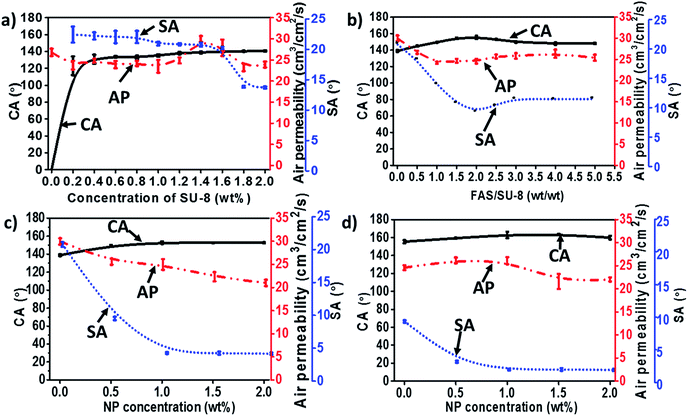
![[thick line, graph caption]](https://www.rsc.org/images/entities/char_e117.gif) ), SA (–··) and air permeability (⋯) of the coated cotton fabrics.
), SA (–··) and air permeability (⋯) of the coated cotton fabrics.